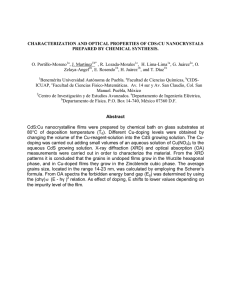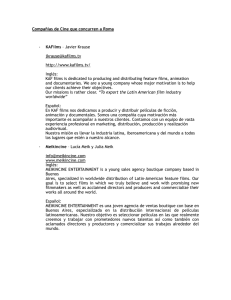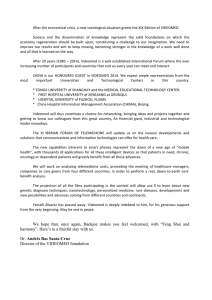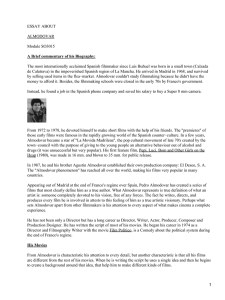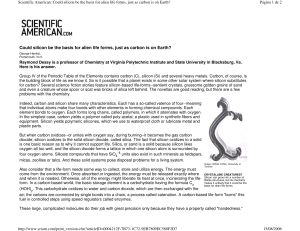Optical and structural properties of SiO x N y H z films deposited by
Anuncio
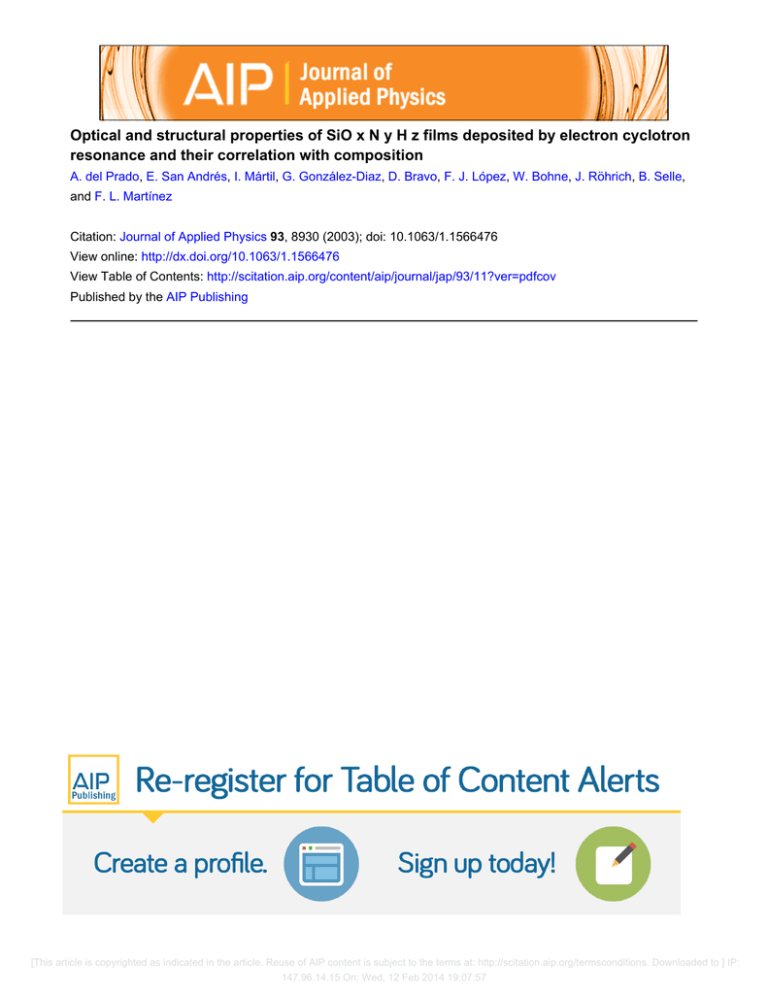
Optical and structural properties of SiO x N y H z films deposited by electron cyclotron resonance and their correlation with composition A. del Prado, E. San Andrés, I. Mártil, G. González-Diaz, D. Bravo, F. J. López, W. Bohne, J. Röhrich, B. Selle, and F. L. Martínez Citation: Journal of Applied Physics 93, 8930 (2003); doi: 10.1063/1.1566476 View online: http://dx.doi.org/10.1063/1.1566476 View Table of Contents: http://scitation.aip.org/content/aip/journal/jap/93/11?ver=pdfcov Published by the AIP Publishing [This article is copyrighted as indicated in the article. Reuse of AIP content is subject to the terms at: http://scitation.aip.org/termsconditions. Downloaded to ] IP: 147.96.14.15 On: Wed, 12 Feb 2014 19:07:57 JOURNAL OF APPLIED PHYSICS VOLUME 93, NUMBER 11 1 JUNE 2003 Optical and structural properties of SiOx Ny Hz films deposited by electron cyclotron resonance and their correlation with composition A. del Prado, E. San Andrés, I. Mártil, and G. González-Diaz Departamento Fı́sica Aplicada III, Universidad Complutense de Madrid, 28040 Madrid, Spain D. Bravo and F. J. López Departamento Fı́sica de Materiales, Universidad Autónoma de Madrid, 28049 Madrid, Spain W. Bohne, J. Röhrich, and B. Selle Abt. Silizium-Photovoltaik und Ionenstrahl-Labor, Hahn-Meitner-Institut, 12489 Berlin, Germany F. L. Martı́nez Departamento Electrónica, Tecnologı́a de Computadores y Proyectos, Universidad Politécnica de Cartagena, 30202 Cartagena, Spain 共Received 30 October 2002; accepted 19 February 2003兲 SiOx Ny Hz films were deposited from O2, N2, and SiH4 gas mixtures at room temperature using the electron cyclotron resonance plasma method. The absolute concentrations of all the species present in the films 共Si, O, N, and H兲 were measured with high precision by heavy-ion elastic recoil detection analysis. The composition of the films was controlled over the whole composition range by adjusting the precursor gases flow ratio during deposition. The relative incorporation of O and N is determined by the ratio Q⫽ (O2 )/ (SiH4 ) and the relative content of Si is determined by R ⫽ 关 (O2 )⫹ (N2) 兴 / (SiH4) where (SiH4), (O2), and (N2) are the SiH4 , O2, and N2 gas flows, respectively. The optical properties 共infrared absorption and refractive index兲 and the density of paramagnetic defects were analyzed in dependence on the film composition. Single-phase homogeneous films were obtained at low SiH4 partial pressure during deposition; while those samples deposited at high SiH4 partial pressure show evidence of separation of two phases. The refractive index was controlled over the whole range between silicon nitride and silicon oxide, with values slightly lower than in stoichiometric films due to the incorporation of H, which results in a lower density of the films. The most important paramagnetic defects detected in the films were the K center and the E ⬘ center. Defects related to N were also detected in some samples. The total density of defects in SiOx Ny Hz films was higher than in SiO2 and lower than in silicon nitride films. © 2003 American Institute of Physics. 关DOI: 10.1063/1.1566476兴 I. INTRODUCTION Silicon oxynitride is a very interesting material for the microelectronics industry due to the possibility to obtain intermediate properties between silicon oxide and silicon nitride. Silicon oxide is widely used as gate dielectric in metal– insulator–semiconductor devices and thin film transistors. However, the decrease of the oxide thickness as the scale of integration increases, results in too high tunnel currents and the diffusion of Boron or p-type dopants from the gate.1,2 The incorporation of N to the oxide increases the dielectric permittivity, so that physically thicker films can be deposited, with the same equivalent oxide thickness, reducing the tunnel currents. Furthermore, the barrier properties against diffusion are improved, as well as the reliability of the devices.1,3,4 Additionally, by an adequate control of the composition of silicon oxynitride, it is possible to obtain a lower mechanical stress than in silicon nitride, which is of great interest for its application as passivation dielectric in multilevel metallization processes.5 Finally, the possibility to control the refractive index between the silicon nitride and silicon oxide values allows several optical applications, such as graded index films or antireflection coatings.6 – 8 Concerning the growth of silicon oxynitride films 共in the following SiOx Ny Hz ), research is mainly focused on those techniques with a low thermal budget, according to the requirements of ultralarge scale integration technology, such as rapid thermal processing4,9,10 or different Plasma Enhanced Deposition techniques.1,5,6,11–15 Among these, the electron cyclotron resonance plasma chemical vapor deposition 共ECR-PECVD兲 method shows several interesting advantages in addition to the low temperature requirement. It does not require the presence of a cathode, which is specially important in processes using corrosive gases. Substrates are placed outside the plasma region, so that damage due to ion bombardment is reduced. Finally, a very high activation of the precursor gases is achieved, which allows the use of N2 instead of NH3 as a source of N atoms, thus reducing the incorporation of H to the films. In this work the properties of SiOx Ny Hz thin films deposited by ECR-PECVD at room temperature are studied. By 0021-8979/2003/93(11)/8930/9/$20.00 8930 © 2003 American Institute of Physics [This article is copyrighted as indicated in the article. Reuse of AIP content is subject to the terms at: http://scitation.aip.org/termsconditions. Downloaded to ] IP: 147.96.14.15 On: Wed, 12 Feb 2014 19:07:57 del Prado et al. J. Appl. Phys., Vol. 93, No. 11, 1 June 2003 TABLE I. Precursor gas flow ratios for the different samples. R⫽ 关 (O2) ⫹ (N2) 兴 / (SiH4) and Q⫽ (O2)/ (SiH4). Total gas flow was set at 10.5 sccm. Sample series R Q R0.88 R1.6 R5.0 R9.1 Q0.8 0.88 1.6 5.0 9.1 0.88 –10.7 0.13–0.79 0–1.6 0–5.0 0– 4.5 0.8 using a wide range of different gas flow ratios during deposition, samples of very different compositions and properties were obtained. The combination of accurate composition measurements by heavy-ion elastic recoil detection analysis 共HI-ERDA兲, with techniques for optical and structural characterization, such as Fourier transform infrared 共FTIR兲 spectroscopy, ellipsometry, and electron paramagnetic resonance 共EPR兲, has allowed a detailed study of the correlation between deposition parameters, film composition, and the optical and structural properties. II. EXPERIMENT The films were deposited using a commercial ECR reactor 共Astex AX4500兲 attached to a stainless steel deposition chamber. O2 , N2 共which are fed directly into the plasma chamber兲 and SiH4 共which is introduced into the deposition chamber by means of a dispersal ring兲 were used as precursor gases. The flow was controlled by mass flow controllers. More details on the deposition system are given elsewhere.16 In all depositions the total gas flow, pressure and microwave power were kept constant at 10.5 sccm, 9⫻10⫺4 mbar, and 100 W, respectively. The substrates were not intentionally heated and the deposition temperature was about 50 °C. Samples of different compositions were obtained by changing the flow ratio of the precursor gases. To characterize the deposition process the parameters R⫽ 关 (O2) ⫹ (N2) 兴 / ()SiH4) and Q⫽ (O2)/ (SiH4) were used, where (SiH4), (O2), and (N2) are the SiH4, O2, and N2 gas flows, respectively. As the total flow is constant, the parameter R determines the SiH4 partial pressure during deposition, with the highest SiH4 pressure for the lowest value of R. The parameter Q controls the relative flow of O2 and N2 for a given value of R. Table I summarizes the gas flows used for the different sample series deposited in this work. Along the article, samples will be named according to the values of the parameters R and Q used during deposition 共for instance, sample R1.6Q0.80 means that it has been deposited at R ⫽1.6 and Q⫽0.80兲. The samples were deposited on high resistivity 共80 ⍀ cm兲 p-type Si共111兲 substrates. The substrates were cleaned using standard procedures.17 The thickness of the films was about 300 nm. The composition of the samples of series R1.6 and R5.0 共see Table I兲 was measured with the HI-ERDA technique, using 150 MeV 86Kr⫹ ions. The identification of the species present in the film was performed using the time of flight technique. This technique allows the determination of the 8931 absolute concentrations of all the species present in the SiOx Ny Hz films, including H, without need of any reference sample, with a very high sensitivity 共0.01 at. %兲 and precision 共about 3%兲. Details on the HI-ERDA setup and the measurements are given elsewhere.18,19 The bonding structure of the films was investigated by FTIR spectroscopy. A Nicolet 5PC spectrometer operating at normal incidence and transmission mode was used for the measurements. Additionally, the bonded H content was evaluated from the Si–H and N–H stretching bands using the calibration factors calculated by Lanford and Rand.20 The thickness of the films and the refractive index at the He–Ne laser wavelength 共632.8 nm兲 were measured by ellipsometry, using a Plasmos E2302 ellipsometer with incidence and detection angles both set at 70°. Finally, the density of paramagnetic defects was determined by EPR measurements, using a Bruker ESP 300E X band spectrometer. The microwave power was set at 0.5 mW to avoid saturation of the signal and the density of defects was evaluated using a weak pitch standard. For these measurements stacks of films deposited in the same process for a total thickness between 1500 and 2500 nm were used. III. RESULTS A. Composition „HI-ERDA… measurements As the main interest of SiOx Ny Hz is the control of its properties between those of silicon nitride and oxide, it appeared to be useful to deal with a parameter which could serve as an indicator of how close the composition is to either silicon nitride or silicon oxide. For stoichiometric silicon oxynitride films, SiOx Ny , with no H content and only Si–O and Si–N bonds present in the films, such a parameter 共which we will call ␣兲 can be defined as the ratio between the concentration of Si–O bonds and the total concentration of bonds: ␣⫽ 2 关 O兴 2x 关 Si–O兴 ⫽ ⫽ 关 Si–O兴 ⫹ 关 Si–N兴 2 关 O兴 ⫹3 关 N兴 2x⫹3y 共1兲 where the coordination numbers of O and N have been taken into account. This parameter ␣ can be understood as the fraction of oxide present in the SiOx Ny film, so that ␣⫽0 corresponds to SiN1.33 , ␣⫽1 to SiO2, and ␣⫽0.5 is the exact middle composition. The meaning of ␣ may be better understood if the SiOx Ny formula is written as 共SiO2兲␣ (SiN1.33) 1⫺ ␣ . Note that writing the silicon oxynitride formula in this way does not imply a separation of two phases in the films. This subject will be discussed in the following section. Furthermore, this parameter ␣ correlates with the relative concentration of the SiO j N4⫺ j tetrahedron units in the random bonding model 共RBM兲.21 For samples containing H, which deviate from the stoichiometric composition, the parameter ␣ given by Eq. 共1兲 is not exactly the oxide fraction as explained above, and a correction should be made. For instance, for samples with a concentration of N–H bonds proportional to the N content, i.e., 关N–H兴⫽X NH关 N兴 , but no significant concentrations of Si–Si or Si–H bonds, the oxide fraction would be given by22 [This article is copyrighted as indicated in the article. Reuse of AIP content is subject to the terms at: http://scitation.aip.org/termsconditions. Downloaded to ] IP: 147.96.14.15 On: Wed, 12 Feb 2014 19:07:57 8932 del Prado et al. J. Appl. Phys., Vol. 93, No. 11, 1 June 2003 FIG. 1. Composition parameter ␣ 关Eq. 共1兲兴 as a function of the deposition gas flow ratio Q⫽ (O2)/ (SiH4) for series R1.6 and R5.0, deposited at different SiH4 partial pressures. Line is drawn as a guide to the eye. ␣ ⬘⫽ 2x 关 Si–O兴 ⫽ . 关 Si–O兴 ⫹ 关 Si–N兴 2x⫹ 共 3⫺X NH兲 y FIG. 3. Refractive index 共upper兲 and mass density of the films 共lower兲 as a function of the composition parameter ␣ for samples of series R1.6 and R5.0. The solid lines correspond to the calculated values for stoichiometric SiOx Ny films. 共2兲 For low H content, the differences between the parameter ␣ 关Eq. 共1兲兴 and the corrected value ␣ ⬘ 关Eq. 共2兲兴 are almost negligible 共below 3% for our samples兲. So, to simplify matters, the value of the parameter ␣ given by Eq. 共1兲 is used in the following to characterize the composition of our films. The control of the composition is realized by adjusting the gas flow ratios during deposition. Figure 1 shows the measured composition parameter ␣ as a function of the gas flow ratio Q⫽ (O2)/ (SiH4), for samples of series R1.6 and R5.0, deposited at different SiH4 partial pressures. As shown in the figure, the oxide fraction ␣ is mainly determined by the parameter Q, regardless of the value of R. The measured concentrations 共at. %兲 of each of the species present in the SiOx Ny Hz films 共Si, O, N, and H兲 are shown in Fig. 2 as a function of the composition parameter ␣, for samples of series R1.6 and R5.0. The expected concentrations for stoichiometric SiOx Ny 共with no H content and only Si–O and Si–N bonds, so that the relation 2x⫹3y⫽4 is verified兲11 are also shown as solid lines for comparison. While the obtained O content is essentially the same as in stoichiometric films, both the Si and N contents are slightly lower, especially for compositions close to silicon nitride. This result is related to the presence of H, which is higher for those compositions. B. Ellipsometry measurements Figure 3 shows the mass density 共兲 of the films, calculated from the HI-ERDA results and the thickness obtained by ellipsometry, as a function of composition, for samples of series R1.6 and R5.0. The refractive index 共n兲, measured at ⫽632.8 nm is also shown in Fig. 3. The density and refractive index values corresponding to stoichiometric H-free SiOx Ny are plotted as solid lines for comparison. These curves were calculated taking ⫽2.2 g cm⫺3 and n⫽1.46 for SiO2, 23 and ⫽3.1 g cm⫺3 and n⫽2.05 for Si3N4, 23 and assuming a linear dependence on the parameter ␣. Both the density and the refractive index of the deposited samples are slightly lower than the expected for stoichiometric films. According to the work of Sassella et al.24 the refractive index in SiOx Ny Hz films is related to the mass density, so that a decrease in the density results in a decrease of the refractive index. As shown in Fig. 2, the incorporation of H results in lower concentrations of Si and N in our samples than in stoichiometric ones, which in turn results in a lower density. We attribute the lower refractive index values to this lower density of the films. Deposition rate was also calculated from the measured thickness. The deposition rate is mainly determined by the parameter R⫽ 关 (O2)⫹ (N2) 兴 / (SiH4),which controls the SiH4 partial pressure. Figure 4 shows the deposition rate for samples of series Q0.8 as a function of R. For R values up to R⫽1.5, high deposition rates 共above 15 nm/min兲 are observed. For greater values of R(R⬎3) the deposition rate significantly drops down. C. FTIR spectroscopy measurements 1. Si – H and N – H stretching bands The Si–H and N–H bond concentrations for samples of FIG. 2. Atomic percentages of Si, O, N, and H, measured by HI-ERDA, for series Q0.8 are shown in Fig. 4, as a function of the paramseries R1.6 and R5.0 as a function of the composition parameter ␣ 关Eq. 共1兲兴. eter R, together with the deposition rate. The bond concenThe calculated values for stoichiometric SiOx Ny films are shown as solid trations were evaluated from the Si–H and N–H stretching lines. [This article is copyrighted as indicated in the article. Reuse of AIP content is subject to the terms at: http://scitation.aip.org/termsconditions. Downloaded to ] IP: 147.96.14.15 On: Wed, 12 Feb 2014 19:07:57 del Prado et al. J. Appl. Phys., Vol. 93, No. 11, 1 June 2003 FIG. 4. Si–H and N–H bond concentrations and deposition rate as a function of the gas flow ratio R⫽ 关 (O2)⫹ (N2) 兴 / (SiH4) for series Q0.8. Lines are drawn as a guide to the eye. absorption bands, using the calibration factors given by Lanford and Rand.20 For R values below 1, the Si–H concentration is much higher than the N–H concentration, suggesting that these samples may be Si rich. On the other hand, for greater values of R, the N–H concentration is higher, with a negligible Si–H concentration for R⬎3. By the term ‘‘Si rich’’ we understand samples with a relative content of Si higher than in stoichiometric films, with respect to N and O 共i.e., 2x⫹3y⬍4). Still, the presence of H may result in a lower total Si content than in stoichiometric films, in a similar way as shown in Fig. 2. In addition to the H concentration obtained from the area of the absorption bands, the FTIR spectroscopy measurements provide useful information about the structure of bonds of the films. In particular, the Si–H stretching band is very sensitive to the chemical environment of the Si–H bond, so that as the electronegativity of the neighbor atoms increases, the band shifts to higher wave numbers.25–27 Figure 5 shows the absorption spectrum in the Si–H stretching band range for several samples. The composition for the sample deposited at R⫽0.88 and Q⫽0.49 is very close to silicon nitride. A single band located about SiH ⫽2168 cm⫺1 is observed. This value is intermediate between the value for the (SiN2) – Si–H configuration ( SiH ⫽2140 cm⫺1) 25,27 and the (N3) –Si–H configuration ( SiH ⫽2200 cm⫺1), 25,27 which supports the conclusion that for 8933 FIG. 6. Wave number of the Si–H stretching band as a function of the composition parameter ␣, for samples of series R1.6. Line is drawn as a guide to the eye. this low value of R Si-rich films 共or films with an excess Si content with respect to stoichiometric samples兲 are obtained. For R⫽0.88 and Q⫽0.8, an intermediate composition between nitride and oxide is obtained. For this sample two peaks can be resolved, one located at SiH⫽2168 cm⫺1, characteristic of Si-rich silicon nitride, as explained above, and the other located at SiH⫽2238 cm⫺1, which is slightly lower than the frequency corresponding to the (O3) –Si–H configuration ( SiH⫽2245– 2265 cm⫺1) 25–28 in SiO2. The lower value observed in our work is attributed to contributions of configurations in which O atoms are substituted by Si atoms, such as (SiO2) –Si–H ( SiH⫽2180–2195 cm⫺1). 25–28 The behavior of the sample deposited at R⫽0.97 and Q⫽0.8 is very similar to the previous one, although for this sample the oxide peak slightly shifts to higher wave numbers, due to the lower Si content in this sample, and the nitride peak becomes less clear, probably also due to the lower Si concentration, so that the contribution of (SiN2) – Si–H groups is less significant and the wave number of the band approaches 2200 cm⫺1. For samples deposited at higher values of R, the Si–H band shows essentially a single peak that shifts to higher wave numbers as the composition changes from silicon nitride to silicon oxide, due to the higher electronegativity of O with respect to N.25 This behavior is shown in Fig. 6 for the samples of series R1.6. 2. Si – OÕSi – N stretching band We have studied the absorption spectrum of our deposited SiOx Ny Hz films as a function of the deposition parameters. Figure 7 shows the IR spectra in the 400–1400 cm⫺1 range for samples deposited at Q⫽0.8 共series Q0.8兲, for which intermediate compositions are obtained, as a function of R. For the lowest values of R (R⬍1) two peaks are clearly distinguished, one located at 872 cm⫺1, close to the characteristic value for the Si–N stretching vibration in Si3N4 共835 cm⫺1), and the other at 1026 cm⫺1, close to the value for the Si–O stretching vibration in SiO2 共1075 cm⫺1). FIG. 5. Absorption spectrum 共Si–H stretching band兲 for three representative samples deposited at R⬍1. [This article is copyrighted as indicated in the article. Reuse of AIP content is subject to the terms at: http://scitation.aip.org/termsconditions. Downloaded to ] IP: 147.96.14.15 On: Wed, 12 Feb 2014 19:07:57 8934 del Prado et al. J. Appl. Phys., Vol. 93, No. 11, 1 June 2003 FIG. 7. Absorption spectrum 共Si–O/Si–N stretching band兲 for series Q0.8 for different values of R. For higher values of R, the separation of the two peaks becomes gradually less pronounced, with a single peak being observed for R⬎3. Figure 8 shows the absorption spectra for samples of series R5.0, 共deposited at R⫽5.0兲, for different values of the parameter Q. As Q is increased 共the composition changes from silicon nitride to oxide兲 the band continuously shifts from the characteristic nitride value to the oxide value. For the samples showing a single Si–O/Si–N stretching band, another important parameter is the full width at half maximum 共FWHM兲 of this band. This parameter is related to the structural order of the film and the dispersion of different chemical environments, with higher values of the FWHM indicating higher disorder and higher dispersion of different environments.29,30 Figure 9 shows the FWHM of the Si–O/Si–N stretching band for samples of series R1.6 and R5.0 as a function of the composition parameter ␣. As composition changes from silicon nitride to silicon oxide, the FWHM increases until reaching a maximum value for intermediate compositions, and then decreases. The same behavior has been reported by other authors.11,30 The maximum value of the FWHM is obtained for values of ␣ around 0.5, suggesting that the maximum dispersion of different chemical environments corresponds to this composition. FIG. 9. FWHM of the Si–O/Si–N stretching band as a function of the composition parameter ␣ for samples of series R1.6 and R5.0. One of the most extended models to describe the bonding structure of the SiOx Ny Hz is the random bonding model 共RBM兲 originally proposed by Philipp.31 According to this model, the silicon oxynitride is formed by tetrahedral structural units, with a Si atom at the center and different occupation of the vertices of the tetrahedron by N and O atoms. The five fundamental tetrahedrons may be indexed according to the number of N or O atoms present: SiO j N4⫺ j , with j⫽ 0, 1, 2, 3, 4. Neglecting the presence of H, the probability P j or relative concentration of each tetrahedron is given by21 P j ⫽ 共 4j 兲 ␣ j 共 1⫺ ␣ 兲 4⫺ j . 共3兲 The dielectric function of the SiOx Ny and, therefore, the absorption coefficient can be obtained by combining the dielectric function of each fundamental tetrahedron according to the effective medium theory.21 In addition, the presence of bonded H or Si–Si bonds can be taken into account by increasing the possible types of tetrahedrons, so that Si–H, N–H and Si–Si bonds are included.24,32 In order to study the dispersion of different chemical environments, the probability P j calculated from equation 共3兲 for ␣ values in the range from 0 to 0.5 is shown in Fig. 10. 共Note that for ␣⬎0.5, the distribution of tetrahedrons would be equivalent to that for 1⫺␣, exchanging j⫽0 for j⫽4 and j⫽1 for j⫽3). Although the shape of the Si–O/ Si–N absorption band is not only determined by the relative FIG. 10. Probability P j of each tetrahedron of the type SiO j N4⫺ j , according to the RBM 关Eq. 共3兲兴, for different values of the composition parameter FIG. 8. Absorption spectrum 共Si–O/Si–N stretching band兲 for series R5.0 for different values of Q. ␣. Lines are drawn as a guide to the eye. [This article is copyrighted as indicated in the article. Reuse of AIP content is subject to the terms at: http://scitation.aip.org/termsconditions. Downloaded to ] IP: 147.96.14.15 On: Wed, 12 Feb 2014 19:07:57 del Prado et al. J. Appl. Phys., Vol. 93, No. 11, 1 June 2003 FIG. 11. EPR spectra of selected SiOx Ny Hz samples with different composition. concentrations of the different tetrahedrons, but also by the oscillator strength and resonance width of the dielectric function of each tetrahedron,21 it is clear in Fig. 10 that the maximum dispersion of different tetrahedrons is obtained for values of ␣ around 0.5. The validity of the RBM for our films will be discussed later. D. EPR measurements The density of defects with paramagnetic activity in the films was studied by EPR. Figure 11 shows representative EPR spectra for samples deposited at different gas flow ratios. The derivative spectrum is shown, and the resonance condition for the absorption is33 h ⫽g B B, 共4兲 where is the microwave frequency 共⫽9.5 GHz兲, B is the Bohr magnetron, B is the applied magnetic field, and g is the spectroscopic splitting factor, characteristic of each defect. The composition of sample R5.0Q0.0 is essentially silicon nitride 共␣⫽0.05兲. The EPR spectrum of this sample shows a dominant feature with a g factor around g⫽2.004. This signal is attributed to the K center (N3wSi↑,g ⫽2.0028) with possible contributions in which N atoms are substituted by Si atoms, such as SiN2 wSi↑, Si2 NwSi↑, or even Si3 wSi↑. For these configurations the value of g increases from 2.0028 for N3wSi↑ to 2.0055 for Si3wSi↑. 34 For silicon oxide, 共sample R9.1Q4.5, ␣⫽1.0兲, the characteristic signal of the E ⬘ center (O3wSi↑,g⫽2.0018) is observed.35 For samples of intermediate composition, the behavior is different depending on the value of the gas flow ratio R. For those samples deposited at R⫽1.6, two signals can be distinguished in the EPR spectrum; one close to the characteristic g value of the K center and the other corresponding to the E ⬘ center. On the other hand, for sample R5.0Q0.61 共␣ ⫽0.41兲, deposited at a high R value, the EPR signal does not split up and shows a single feature located at g⫽2.004. This signal is due to the Si dangling bond. The high observed value of g suggests that the signal is mainly due to defects similar to the K center, rather than defects with a configuration similar to that of the E ⬘ center. A weak signal is also observed around g⫽2.023. This signal is very close to one of 8935 FIG. 12. Overall paramagnetic defect density as a function of the composition parameter ␣. Line is drawn as a guide to the eye. the three characteristic lines of the N dangling bond defect. The most intense signal of this defect is located at g⫽2.0055 and the third very weak line appears at lower values of g.36 Therefore, the line observed at g⫽2.023 in the spectrum of Fig. 11 for sample R5.0Q0.61 共␣⫽0.41兲 is tentatively attributed to the N dangling bond center, with the principal line of the defect masked in the dominant signal around g⫽2.004. The third line may be too weak to be distinguished from noise. Finally, the EPR spectrum of sample R5.0Q1.43, of composition very close to silicon oxide 共␣⫽0.94兲 shows some interesting features. The intense signal appearing at g⫽2.0008 is attributed to an E ⬘ -like center where an O atom is substituted by a Si atom (SiO2wSi↑). 37 Additionally, a weak doublet with a separation of 22 G is observed. Similar structures have been observed by other authors in silicon oxide films and attributed to defects related to N.38,39 In fact, these defects show a spectrum with three lines, but in our samples the central line is masked by the intense signal at g⫽2.0008. Since we have not detected this doublet in N-free SiOx samples,40 we conclude that this 22 G doublet is related to the presence of N in the film. The defect may be in fact the N04 center, as explained by Stathis et al.38 Figure 12 shows the total concentration of paramagnetic defects as a function of composition. The highest defect density is obtained for silicon nitride films 共␣⫽0兲. For SiOx Ny Hz films the defect density is lower than in nitride films and remains roughly constant over the whole composition range. For SiO2 samples 共␣⫽1兲 the density of defects significantly decreases with respect to SiOx Ny Hz films. While the incorporation of O to SiNy Hz films seems to have a beneficial effect, the incorporation of N to the SiO2 results in a significant increase of the density of defects. It must be noted, however, that defects with no paramagnetic activity may also be present in the films. IV. DISCUSSION A. Control of composition According to the results shown in Figs. 1 and 2, it becomes apparent that our ECR-PECVD process is capable of producing films with well controlled compositions over the whole range between silicon nitride 共␣⫽0兲 and silicon oxide 共␣⫽1兲. It must also be noted that it has been possible to [This article is copyrighted as indicated in the article. Reuse of AIP content is subject to the terms at: http://scitation.aip.org/termsconditions. Downloaded to ] IP: 147.96.14.15 On: Wed, 12 Feb 2014 19:07:57 8936 del Prado et al. J. Appl. Phys., Vol. 93, No. 11, 1 June 2003 obtain compositions close to SiNy Hz with relatively low (N2)/ (O2 ) ratios 共for instance, for the sample deposited at R⫽1.6 and Q⫽0.21, the value ␣⫽0.12 is obtained with (N2) / (O2)⫽6.7). Keeping the flows of all the precursor gases in the same order of magnitude makes the control more reliable, enhancing the reproducibility of the deposition process. This is possible due to the high activation efficiency of the ECR plasma, which allows an efficient activation of N2. The control of the composition allows to control the refractive index between the silicon nitride value 共n⫽1.98 for our samples兲 and the silicon oxide value 共n⫽1.46兲, as shown in Fig. 3. This is of special interest for optical applications, such as graded index films or antireflection coatings.6 – 8 The composition parameter ␣ is mainly determined by the O2 to SiH4 gas flow ratio Q⫽ (O2)/ (SiH4), regardless of the value of the parameter R⫽ 关 (O2) ⫹ (N2) 兴 / (SiH4), as evidenced by Fig. 1. However, the parameter R has also a very important influence on the properties of the deposited films. For SiNy Hz samples, deposited in the same reactor and under the same conditions, R determines the relative N and Si content.41 For low values of R 共high SiH4 partial pressure兲 Si-rich films are obtained, while for high values of R 共low SiH4 partial pressure兲 N-rich films are obtained. Additionally, for Si-rich films, the Si–H bond concentration is higher than the N–H bond concentration, while the opposite result 共关N–H兴⬎关Si– H兴兲 is obtained for N-rich silicon nitride. For silicon oxide (SiOx ), the same behavior is observed.42 For low values of R, suboxide films (x⬍2) are obtained, with a significant concentration of Si–H bonds; while for high values of R stoichiometric SiO2 films are obtained. The same trend is observed for the SiOx Ny Hz films 共see Fig. 4兲. For low values of R (R⬍1) Si-rich films are obtained, with higher concentrations of Si–H bonds than N–H bonds. As the parameter R is increased, the N–H bond concentration increases and the Si–H bond concentration decreases, becoming below detection limit for R⬎3. These results can be explained by considering the mechanics of the deposition process. O–O, O–N, and N–N bonds are not stable and it can be assumed that these bonds are not present in the SiOx Ny Hz films.32 Keeping in mind that each atom type comes from a single gas precursor 共O atoms from O2; N atoms from N2; and Si atoms from SiH4), the possible mechanisms for the film to grow are the following: reaction of O2 and SiH4 to form Si–O bonds; reaction of N2 and SiH4 to form Si–N and N–H bonds; and finally, reaction of SiH4 with itself to form Si–Si and Si–H bonds. Here the term ‘‘reaction’’ is not quite exact, as the deposition process involves several intermediate steps; such as activation of the precursor gases, transport of the activated species to the substrate and surface reactions to grow the film. All of the three above mentioned principal reaction chains are limited by the SiH4 partial pressure, so that they are strongly competitive against each other. This result is evidenced by the behavior of the deposition rate shown in Fig. 4, which is much higher for the higher SiH4 partial pressures during the deposition 共lower values of R兲. For high values of R 共low SiH4 partial pressure兲, the SiH4 is almost totally consumed in the reactions with N2 and O2, so that the formation of Si–H bonds is negligible, as shown in Fig. 4. The formation of Si–Si bonds for these flow ratios is also expected to be very low. On the other hand, for low values of R there is excess of SiH4 during the process that does not react with N2 and O2, and Si–H and Si–Si bonds are formed so that Si-rich films are obtained. These conclusions are similar to those reported by Smith for conventional PECVD processes.43 Concerning the formation of Si–O and Si–N bonds, as O2 is much more reactive that N2, the formation of Si–O bonds is predominant over the formation of Si–N bonds. For high values of the O2 to SiH4 ratio 共parameter Q兲, almost all the SiH4 reacts with O2 and no significant amount of Si–N bonds is formed, so that oxide composition samples are obtained with ␣⫽1, as shown in Fig. 1. Si–N bonds are only formed when the parameter Q is low enough to provide excess SiH4 which can react with N2. As the parameter Q is decreased, the formation of Si–N bonds is enhanced with respect to the formation of Si–O bonds and the composition approaches silicon nitride 共i.e., ␣ approaches zero兲. For a given value of the parameter Q, a change in R may have a slight influence in the relative concentration of Si–O and Si–N bonds, as the N2 to SiH4 ratio would be affected. However, as shown in Fig. 1, it is the parameter Q which essentially determines the oxide fraction 共parameter ␣兲 of the deposited films. B. Structure of bonds The structure of bonds of SiOx NyHz has been extensively discussed in the literature. Either the absorption coefficient or the imaginary part of the dielectric function may be studied for this analysis, as both magnitudes show characteristic bands of the specific molecular groups present in the material. The most intense absorption signal in the SiOx Ny Hz system corresponds to the Si–O and Si–N stretching oscillations. For SiO2 the Si–O stretching band has a characteristic wave number SiO⫽1075 cm⫺1, 44 while for Si3N4 the Si–N stretching band is located at SiN⫽835 cm⫺1. 21 For SiOx Ny Hz films, many authors find a dominant absorption band, with a single maximum located at intermediate frequencies between those of SiO2 and Si3N4. 1,11–13,30,45,46 This behavior is characteristic of singlephase homogeneous SiOx Ny Hz and its bonding structure is well described by the RBM previously explained 关see Eq. 共3兲兴. However, some authors find that the Si–O and Si–N stretching bands can be clearly distinguished in he absorption spectrum.27,47 This is a strong indication that the RBM is not applicable and that the SiOx Ny Hz film is rather a mixture of two separate phases. As shown in Fig. 7, the structure of bonds of our SiOx Ny Hz films is strongly dependent on the deposition parameter R. For R⬍1 the presence of two clearly distinct peaks 共located at 872 and 1026 cm⫺1) indicates that in these samples separation of two phases occur. However, as these peaks are slightly shifted with respect to the characteristic frequencies of the Si–N and Si–O stretching oscillations in [This article is copyrighted as indicated in the article. Reuse of AIP content is subject to the terms at: http://scitation.aip.org/termsconditions. Downloaded to ] IP: 147.96.14.15 On: Wed, 12 Feb 2014 19:07:57 del Prado et al. J. Appl. Phys., Vol. 93, No. 11, 1 June 2003 Si3N4 and SiO2 ( SiN⫽835 cm⫺1 and SiO⫽1075 cm⫺1, respectively兲, it is suggested that some tetrahedrons of the type SiO j N4⫺ j involving both N and O atoms may also be present. The behavior of the Si–H stretching band, with two distinct peaks for R⬍1 共Fig. 5兲, is consistent with the conclusions derived from the Si–O/Si–N band. It is suggested that the separation of two phases observed in these films is related to the comparatively high relative Si content corresponding to the low values of R during deposition. This proposal is consistent with the results of Cros et al.,27 who found similar spectra in Si-rich films. As the parameter R is increased, the separation of two phases becomes less clear. For R⫽1.3 still two bands can be distinguished, but the Si–O peak appears at lower wave numbers 共1011 cm⫺1) and the Si–N peak looks like a shoulder in the band rather than like an independent peak. In these samples there is still a significant separation of phases, but the amount of intermediate SiO j N4⫺ j tetrahedrons 共j⫽1,2,3兲 is higher. For R⫽1.6 there is a single maximum located at 972 cm⫺1 which can no longer be attributed just to the Si–O vibration, but rather to the combined contribution of different SiO j N4⫺ j tetrahedrons. Still, a shoulder in the band at the wave number corresponding to the Si–N vibration is outlined, suggesting a certain degree of separation of two phases. This conclusion is supported by the EPR spectra shown in Fig. 11, in which two different signals, one characteristic of SiNy Hz 共K center兲, and the other characteristic of SiO2 (E ⬘ center兲 are observed. For this value of R, a single peak which shifts to higher wave numbers as the composition parameter ␣ increases was appreciated in the Si–H stretching band 共Fig. 6兲. It must be taken into account that the EPR technique is much more sensitive than FTIR spectroscopy. Furthermore, the Si–H concentration for samples of series R1.6 is relatively low, so that the Si–H stretching band is weak and it is difficult to resolve its fine structure. It is concluded that for R⫽1.6 near single-phase films are obtained, with a certain degree of separation of two phases. For higher values of R (R⬎3), the trend goes on, with the shoulder becoming less clear so that the samples basically can be regarded as single phase. This conclusion is supported by the behavior of the band shown in Fig. 8 for the samples deposited at R⫽5.0: a continuous shift from the characteristic wave number of SiNy Hz to that of SiO2, as composition is changed. Also, the EPR spectra for R⫽5.0 shows a single feature. Additionally, for the single-phase samples, the maximum value of the FWHM of the Si–O/Si–N band was obtained for the exact middle composition ␣⫽0.5 共Fig. 9兲. This is precisely the composition for which the maximum dispersion of different chemical environments is predicted by the RBM 共Fig. 10兲. So, the results obtained are well in accordance with the RBM. V. CONCLUSIONS SiOx Ny Hz films were deposited at room temperature from O2,N2, and SiH4 gas mixtures. The correlation between the optical and structural properties, the composition and the 8937 deposition parameters was studied. A sensitive and comparatively accurate measurement of the absolute concentration of all involved film components 共including hydrogen兲 was performed by HI-ERDA. By an adequate control of the precursor gas flow ratios, samples with compositions covering the whole range between silicon nitride and silicon oxide were obtained. The incorporation of H in the films results in lower concentrations of Si and N than in stoichiometric films, especially for compositions close to silicon nitride, in which the H content is higher. As O2 is much more reactive than N2, the relative incorporation of O and N in the films is essentially determined by the parameter Q⫽ (O2)/ (SiH4), while the SiH4 partial pressure during deposition, R⫽ 关 (O2)⫹ (N2) 兴 / (SiH4), determines the relative content of Si in the films. For samples deposited at high SiH4 partial pressures 共low values of R兲, evidence of separation of two phases is observed, as the Si–N and Si–O stretching bands can be clearly distinguished. Additionally, the Si–H stretching band shows separate peaks for the (N3) – SiH/共SiN2) – Si–H and the (O3) – Si–H/共SiO2兲–SiH configurations. Also, the signals due to the K and E ⬘ centers are separated in the EPR spectrum. On the other hand, for samples deposited at low SiH4 partial pressures, a single Si–O/Si–N stretching band that shifts from the wave number of silicon nitride to the value of silicon oxide as the composition changes is observed. Similar results are observed for the Si–H band. This behavior, together with a maximum value of the FWHM of the Si–O/ Si–N stretching band for middle compositions is characteristic of single-phase homogeneous samples, with a structure of bonds in agreement with the RBM. It was possible to control the refractive index value over the whole range between silicon nitride and silicon oxide. The obtained values are slightly lower than in stoichiometric films as the incorporation of H results in a lower film density. The most important defect types observed in the EPR spectrum were the Si dangling bonds: the K center and the E ⬘ center, with some variants. Defects directly related to the presence of N were also observed. The overall defect density was highest for silicon nitride films and remained roughly constant over the whole composition range of SiOx Ny Hz films. For SiO2 the density of defects is significantly lower than in the SiOx Ny Hz films. All these findings show that the ECR–PECVD technique is well studied to produce SiOx Ny Hz films at room temperature, with specific and reproducible properties to be fitted to different applications in the microelectronics industry. ACKNOWLEDGMENTS The authors acknowledge C. A. I. de Impalntación Iónica 共U. C. M.兲 for availability of deposition system and Dr. E. Iborra 共E. T. S. I. T. Universidad Politécnica de Madrid兲 for availability of FTIR spectrometer. The work has been partially financed by the CICYT 共Spain兲 under Contract No. TIC 01-1253. Technical support of G. Keiler is gratefully acknowledged. [This article is copyrighted as indicated in the article. Reuse of AIP content is subject to the terms at: http://scitation.aip.org/termsconditions. Downloaded to ] IP: 147.96.14.15 On: Wed, 12 Feb 2014 19:07:57 8938 Y. Ma and G. Lucovsky, J. Vac. Sci. Technol. B 12, 2504 共1994兲. L. Manchanda, G. R. Weber, Y. O. Kim, L. C. Feldman, N. Moryia, B. E. Weir, R. C. Kistler, M. L. Green, and D. Brasen, Microelectron. Eng. 22, 69 共1993兲. 3 E. C. Carr and R. A. Buhrman, Appl. Phys. Lett. 63, 54 共1993兲. 4 T. Arakawa, R. Matsumoto, and A. Kita, Jpn. J. Appl. Phys., Part 1 35, 1491 共1996兲. 5 W. A. P. Claassen, H. A. J. Th. v. d. Pol, A. H. Goemans, and A. E. T. Kuiper, J. Electrochem. Soc. 133, 1458 共1986兲. 6 P. V. Bulkin, P. L. Swart, and B. M. Lacquet, J. Non-Cryst. Solids 187, 484 共1995兲. 7 S. Callard, A. Gagnaire, and J. Joseph, J. Vac. Sci. Technol. A 15, 2088 共1997兲. 8 F. Gaillard, P. Schiavone, and P. Brault, J. Vac. Sci. Technol. A 15, 2777 共1997兲. 9 H. T. Tang, W.N. Lennard, C. S. Zhang, K. Griffiths, B. Li, L. C. Feldman, and M. L. Green, J. Appl. Phys. 80, 1816 共1996兲. 10 I. J. R. Baumvol, F. C. Stedile, J.-J. Ganem, I. Trimaille, and S. Rigo, Appl. Phys. Lett. 70, 2007 共1997兲. 11 L.-N. He, T. Inokuma, and S. Hasegawa, Jpn. J. Appl. Phys., Part 1 35, 1503 共1996兲. 12 S. V. Hattangady, H. Niimi, and G. Lucovsky, J. Vac. Sci. Technol. A 14, 3017 共1996兲. 13 M. J. Hernández, J. Garrido, J. Martı́nez, and J. Piqueras, Semicond. Sci. Technol. 12, 927 共1997兲. 14 A. del Prado, I. Mártil, M. Fernández, and G. González-Dı́z, Thin Solid Films 343–344, 432 共1999兲. 15 A. del Prado, F. L. Martı́nez, M. Fernández, I. Mártil, and G. GonzálezDiaz, J. Vac. Sci. Technol. A 17, 1263 共1999兲. 16 S. Garcia, J. M. Martin, M. Fernández, I. Mártil, and G. González-Diaz, Philos. Mag. 73, 487 共1996兲. 17 F. L. Martinez, I. Mártil, G. González-Diaz, B. Selle, and I. Sieber, J. Non-Cryst. Solids 227–230, 523 共1998兲. 18 W. Bohne, J. Röhrich, and G. Röschert, Nucl. Instrum. Methods Phys. Res. B 136–138, 633 共1998兲. 19 W. Bohne, W. Fuhs, J. Röhrich, B. Selle, I. Sieber, A. del Prado, E. San Andrés, I. Mártil, and G. González-Diaz, Surf. Interface Anal. 34, 749 共2002兲. 20 W. A. Lanford and M. J. Rand, J. Appl. Phys. 49, 2473 共1978兲. 21 T. S. Eriksson and C. G. Granqvist, J. Appl. Phys. 60, 2081 共1986兲. 22 A. del Prado, E. San Andrés, F. L. Martı́nez, I. Mártil, G. González-Diaz, W. Bohne, J. Röhrich, B. Selle, and M. Fernández, Vacuum 67, 507 共2002兲. 23 S. M. Sze, Physics of Semiconductor Devices 共Wiley, New York, 1981兲. 1 2 del Prado et al. J. Appl. Phys., Vol. 93, No. 11, 1 June 2003 24 A. Sassella, P. Lucarno, A. Borghesi, F. Corni, S. Rojas, and L. Zanotti, J. Non-Cryst. Solids 187, 395 共1995兲. 25 G. Lucovsky, Solid State Commun. 29, 571 共1979兲. 26 J.-L. Yeh and S.-C. Lee, J. Appl. Phys. 79, 656 共1996兲. 27 Y. Cros and J. C. Rostaing, Proceedings E: Materials Research Society, Strasbourg, June 1986, p. 77. 28 G. Lucovsky, J. Yang, S. S. Chao, J. E. Tyler, and W. Czubatyj, Phys. Rev. B 28, 3234 共1983兲. 29 A. Sassella, A. Borghesi, F. Corni, A. Monelli, G. Ottaviani, R. Tonini, B. Pivac, M. Bacchetta, and L. Zanotti, J. Vac. Sci. Technol. A 15, 377 共1997兲. 30 D. V. Tsu, G. Lucovsky, M. J. Mantini, and S. S. Chao, J. Vac. Sci. Technol. A 5, 1998 共1987兲. 31 H. R. Philipp, J. Non-Cryst. Solids 8–10, 627 共1972兲. 32 A. Sassella, Phys. Rev. B 48, 14208 共1993兲. 33 J. S. Blakemore, Solid State Physics 共Cambridge University Press, Cambridge, 1985兲. 34 W. L. Warren, J. Kanicki, F. C. Rong, and E. H. Poindexter, J. Electrochem. Soc. 139, 880 共1992兲. 35 W. L. Warren, E. H. Poindexter, M. Offenberg, and W. Müller-Warmuth, J. Electrochem. Soc. 139, 872 共1992兲. 36 W. L. Warren, P. M. Lenahan, and S. E. Curry, Phys. Rev. Lett. 65, 207 共1990兲. 37 S. Hasegawa, S. Sakamori, M. Futatsudera, T. Inokuma, and Y. Kurata, J. Appl. Phys. 89, 2598 共2001兲. 38 J. H. Stathis, J. Chapple-Sokol, E. Tierney, and J. Batey, Appl. Phys. Lett. 56, 2111 共1990兲. 39 T. E. Tsai, D. L. Griscom, and E. J. Friebele, Phys. Rev. B 38, 2140 共1988兲. 40 E. San Andrés, A. del Prado, I. Mártil, G. González-Diaz, F. L. Martinez, D. Bravo, F. J. López, and M. Fernández, Vacuum 67, 525 共2002兲. 41 F. L. Martı́nez, A. del Prado, I. Mártil, G. González-Diaz, W. Bohne, W. Fuhs, J. Röhrich, and B. Selle, Phys. Rev. B 63, 245320 共2001兲. 42 E. San Andrés, A. del Prado, I. Mártil, G. González-Diaz, D. Bravo, and F.J. López, J. Appl. Phys. 92, 1906 共2002兲. 43 D. L. Smith, J. Vac. Sci. Technol. A 11, 1843 共1993兲. 44 P. G. Pai, S. S. Chao, Y. Takagi, and G. Lucovsky, J. Vac. Sci. Technol. A 4, 689 共1986兲. 45 C. M. M. Denisse, K. Z. Troost, J. B. Oude Elferink, F. H. P. M. Habraken, W. F. van der Weg, and M. Hendriks, J. Appl. Phys. 60, 2536 共1986兲. 46 B.-R. Zhang, Z. Yu, G. J. Collins, T. Hwang, and W. H. Ritchie, J. Vac. Sci. Technol. A 7, 176 共1989兲. 47 L. Pinard and J. M. Mackowski, Appl. Opt. 36, 5451 共1997兲. [This article is copyrighted as indicated in the article. Reuse of AIP content is subject to the terms at: http://scitation.aip.org/termsconditions. Downloaded to ] IP: 147.96.14.15 On: Wed, 12 Feb 2014 19:07:57

